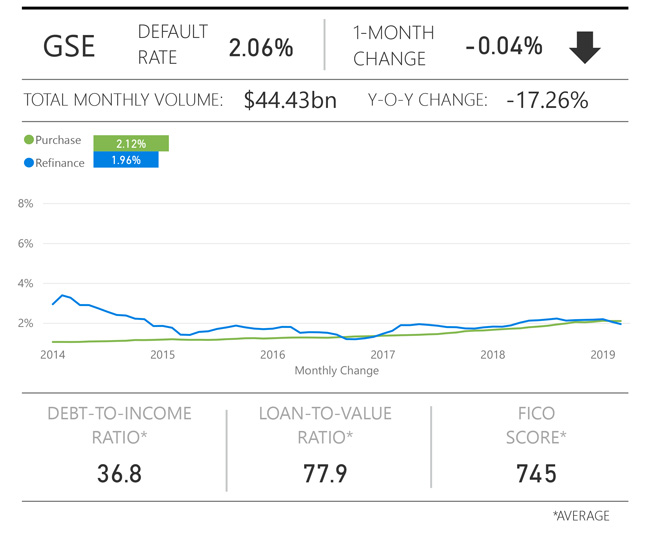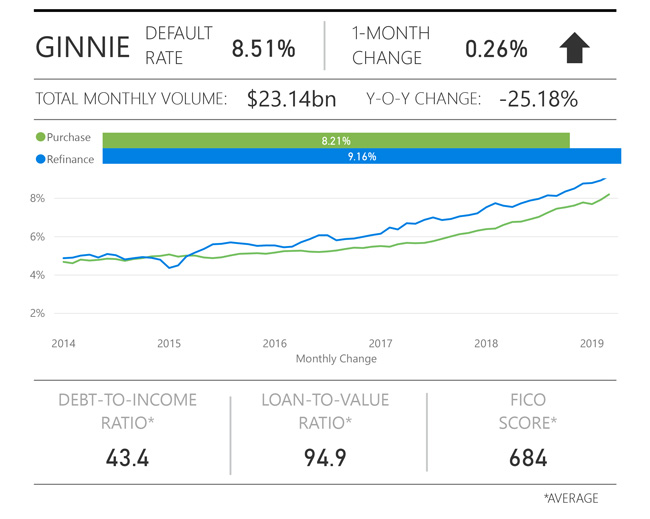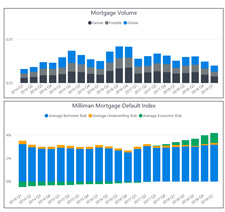Quarterly publication will evaluate default risk of U.S. mortgages delivered to Freddie Mac, Fannie Mae, and Ginnie Mae.
After the subprime mortgage crisis of 2008, the financial services industry instituted various risk mitigation efforts to help guard against the recurrence of a similar rise in mortgage credit risk and its associated effects on the economy. As part of this effort, Milliman is launching the Milliman Mortgage Default Index (MMDI), which estimates the lifetime default rate of a portfolio of mortgages, calculated at the loan level. The intent of the MMDI is to help the mortgage industry and investors measure and benchmark the default risk of U.S.-backed mortgages. This paper is the first installment of our index.
Introduction
The Milliman Mortgage Default Index (MMDI) is a lifetime default rate estimate calculated at the loan level for a portfolio of single-family mortgages. For the purposes of this index, default is defined as a loan that becomes 180 days delinquent or worse. For example, if the MMDI is 10% then we expect the average mortgage originated in that month to have a 10% probability of becoming 180 days delinquent or worse over its lifetime. The results of the MMDI reflect the most recent data acquisition available from Freddie Mac, Fannie Mae, and Ginnie Mae, with measurement dates starting from January 1, 2014.
Key findings
Within the total, we can segment loans by agency. Figure 1 provides the month-end index results for government sponsored entities (GSE) loans (segmented by purchase and refinance) for the first quarter of 2019. Figure 2 provides the index results for Ginnie Mae loans (segmented by purchase and refinance) for the same time period. The MMDI for GSE acquisitions (i.e., loans acquired by Freddie Mac and Fannie Mae) increased to an estimated average default rate of 2.06%, up from 1.81% the year prior. For comparison, in 2007, the actual cumulative 180-day default rate of single-family homes stood at approximately 13.8%, according to Freddie Mac data.1 The MMDI for Ginnie Mae acquisitions increased to an average of 8.51%, up from 6.87% in the year prior.
Figure 1 shows a summary of the latest MMDI. Figure 1 is segmented by loan purpose and filtered to GSE loans.
FIGURE 1: MMDI DASHBOARD FOR GSE LOANS

For reference regarding how rates look during an extreme scenario, below is a summary of the default rates during the great recession:
| Origination Quarter | Purchase | Refinance |
| 10/1/2007 | 16.76% | 11.52% |
| 1/1/2008 | 14.25% | 8.64% |
| 4/1/2008 | 13.01% | 9.17% |
Figure 2 shows a summary of the latest MMDI. Figure 2 is segmented by loan purpose and filtered to Ginnie loans.
FIGURE 2: MMDI DASHBOARD FOR GINNIE LOANS

Agency differences
The credit risk of loans acquired by GSEs have experienced an overall increase in their default risk for both refinance and purchase loans from 2017 through 2019 Q1. The credit risk of loans guaranteed by Ginnie Mae has also experienced an increase in their default risk, and the increase is at a much steeper rate relative to GSE acquisitions, largely due to increases in average borrower debt-to-income ratios and credit score drift.
Another driver of increased risk for recent acquisitions is the increase in anticipated economic risk. Our models estimate a slowdown in home price growth relative to prior years, which puts upward pressure on mortgage default risk.
Components of default risk
The components of the MMDI that inform default risk are borrower risk, underwriting risk, and economic risk. Borrower risk measures the risk of the loan defaulting due to borrower credit quality, initial equity position, and debt-to-income ratio. Underwriting risk measures the risk of the loan defaulting due to mortgage product features such as amortization type, occupancy status, and others. Economic risk measures the risk of the loan defaulting due to historical and forecasted economic conditions.
March borrower risk results
Borrower risk has remained relatively steady with minimal increases across all investors and loan types over the last few months. There has been a loosening credit market which is reflected by borrowers with slightly lower FICO scores, higher loan-to-value (LTV) and higher debt-to-income (DTI) over the past several months which caused an overall increase in the default rates. Increased DTIs have been the largest driver on increased borrower risk.
March underwriting risk results
Underwriting risk represents additional risk adjustments for property and loan characteristics such as occupancy status, amortization type, documentation types, loan term, and others. Underwriting risk after the global financial crisis remains low and is negative for purchase mortgages, which was generally full documentation, fully amortizing loans. We do see some level of underwriting risk for refinance loans, driven by an increase in cash-out refinance loans over the past several years.
March economic risk results
Economic risk is measured by looking at historic and forecasted home prices. Actual home price appreciation has been robust from 2014 through 2019 Q1, which has resulted in embedded appreciation for older originations. This results in reduced credit risk for older cohorts when evaluated as of March 2019. For more recent cohorts, we anticipated slower home price growth, which contributes to increases in economic risk for recent origination years.
About the Milliman Mortgage Default Index
Milliman is proficient in analyzing complex data and building econometric models that are transparent, intuitive, and informative. We have used our expertise to assist multiple clients in developing econometric models for evaluating mortgage risk both at point of sale and for seasoned mortgages.
The Milliman Mortgage Default Index (MMDI) uses econometric modeling to develop a dynamic model that is used by clients in multiple ways including analyzing, monitoring, and ranking the credit quality of new production, allocating servicing sources, and developing underwriting guidelines and pricing. Because the MMDI produces a lifetime default rate estimate at the loanlevel, it is used by clients as a benchmarking tool in origination and servicing. The MMDI is constructed by combining three important components of mortgage risk: borrower credit quality, underwriting characteristics of the mortgage, and the economic environment presented to the mortgage. The MMDI was developed, and is frequently updated, using a robust dataset of over 30 million mortgage loans.
Milliman is one of the largest independent consulting firms in the world and has pioneered strategies, tools and solutions worldwide. We are recognized leaders in the markets we serve. Milliman insight reaches across global boundaries, offering specialized consulting services in mortgage banking, employee benefits, healthcare, life insurance and financial services, and property and casualty insurance. Within these, Milliman consultants serve a wide range of current and emerging markets. Clients know they can depend on us as industry experts, trusted advisers, and creative problemsolvers.
Milliman's Mortgage Practice in Milwaukee is dedicated to providing strategic, quantitative, and other consulting services to leading organizations in the mortgage banking industry. Past and current clients include many of the nation's largest banks, private mortgage guaranty insurers, financial guaranty insurers, institutional investors, and governmental organizations.
1Single Family Loan-Level Dataset Summary Statistics. Freddie Mac. Retrieved on April 19, 2019, from http://www.freddiemac.com/fmac-resources/research/pdf/summary_statistics.pdf.
